Gatekeeper NetSuite Integration Guide
Learn how to setup the NetSuite integration and begin syncing Gatekeeper onboarded vendors into NetSuite
![]() Estimated Read Time: 13 minutes
Estimated Read Time: 13 minutes
Sections in this article:
NetSuite Setup Steps
The following sections of this guide will cover the setup steps required in NetSuite.
Installation Prerequisites
Certain features must be enabled in NetSuite before installing Gatekeeper’s SuiteApp. To do this:
- As an Administrator, navigate to Setup > Company > Enable Features.

- Navigate to the SuiteCloud sub-tab.

- Under the Manage Authentication section, ensure that the SuiteSignOn and Token-Based Authentication checkboxes are selected.

- Review and agree to the Terms of Service.
- Under the SuiteTalk (Web Services) section, ensure that the SOAP Web Services and REST Web Services checkboxes are selected.

- Under the SuiteCloud Development Framework section, ensure that the SuiteCloud Development Framework checkbox is selected.

- Review and agree to the Terms of Service.
- Click Save.
Installation
Gatekeeper’s SuiteApp is available from the SuiteApp Marketplace, and can be installed by following these steps:
- Navigate to the SuiteApp Marketplace by either:
- Clicking SuiteApps from the navigation bar (if available).

- Typing SuiteApp into the global search and selecting SuiteApp Marketplace.

- Clicking SuiteApps from the navigation bar (if available).
- Locate the Gatekeeper SuiteApp using Search Apps, then click the corresponding tile.
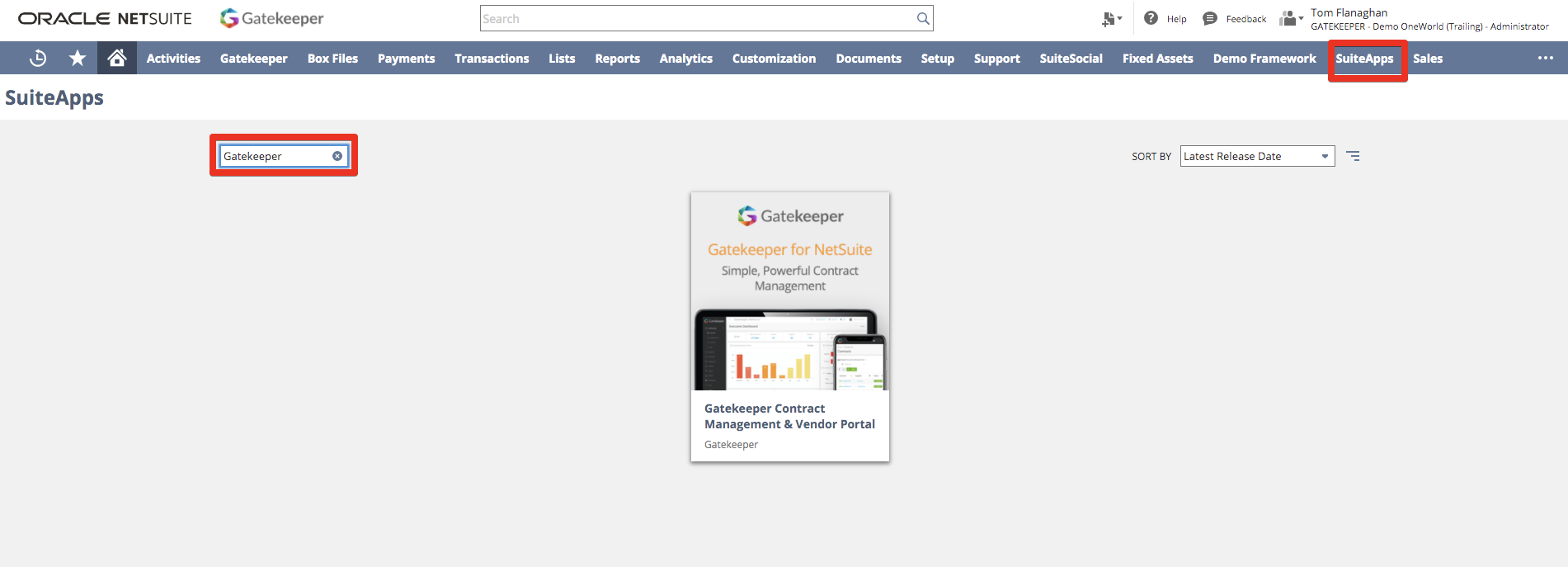
- Click Install.
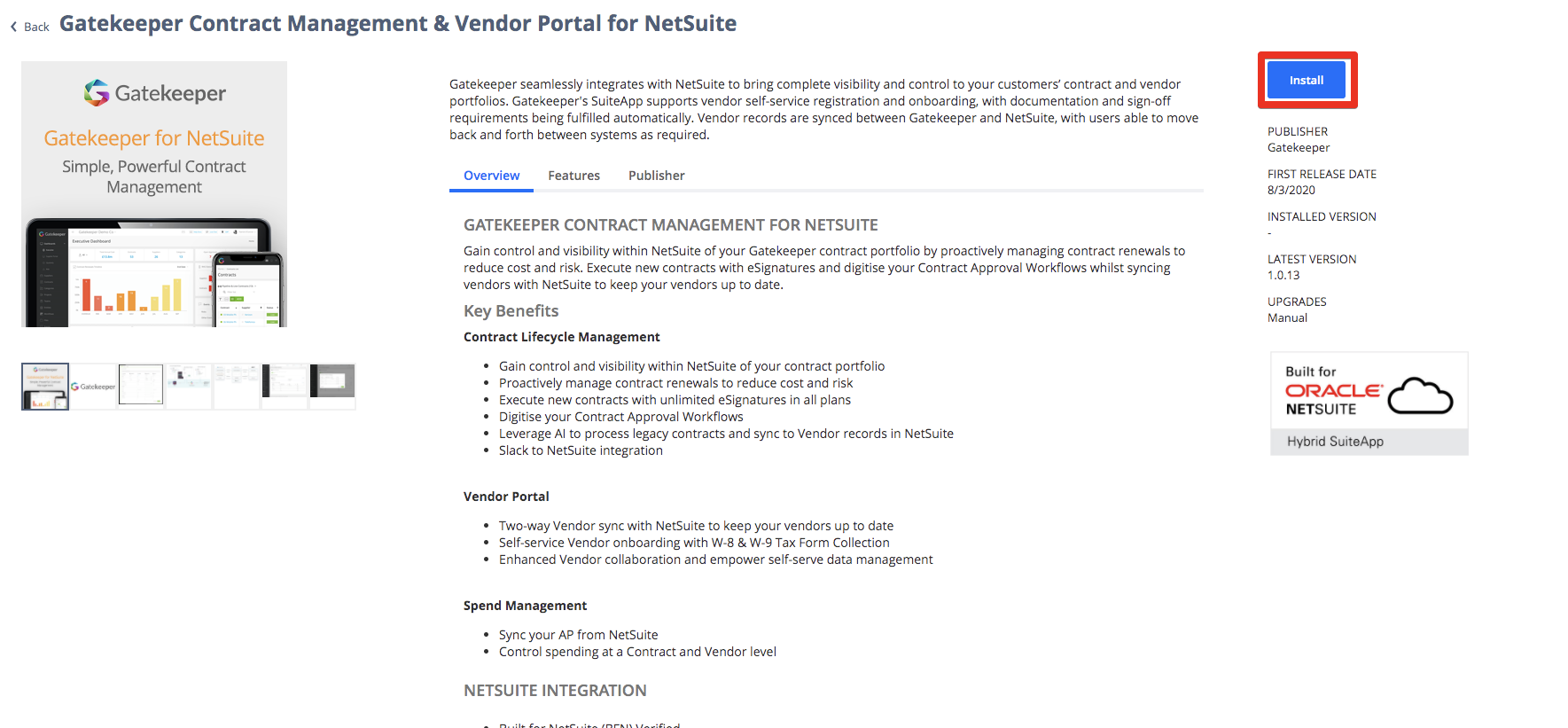
- This page will display the progress, and once complete will show the status as Installed.
SuiteApp Permission
Integration Configuration
Note: The following steps only need to be completed during the initial installation.
Configure Users and Roles
- Select an appropriate User for the integration and edit the record in NetSuite.
- Under the Access subtab, assign the Gatekeeper Integration role from the SuiteApp.

- Click Save.
Create an Access Token
- Navigate to Setup > Users/Roles > Access Tokens.
- Click New Access Token.
- Select the Application (Integration Record), User, and Role configured in the previous steps:

- Click Save.
- Make a note of the Token ID and Token Secret for use during setup in Gatekeeper.
Note: For security reasons, these values are shown only once.
Connect to the Gatekeeper API
Navigate to Setup > Gatekeeper > Gatekeeper Setup and complete the form using the below table for guidance, ensuring you click Save once complete.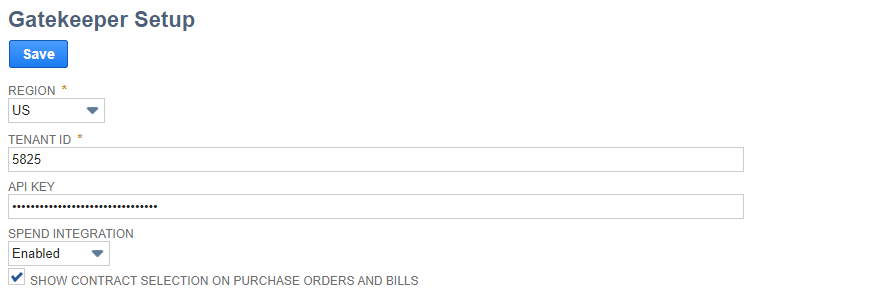
| Configuration | Description |
| Region |
The region your Gatekeeper tenant is located. This can be found in the URL of your tenant. e.g. https://us.gatekeeperhq.com/5825 |
| Tenant ID |
The ID of your Gatekeeper tenant. This can be found in the URL of your tenant. e.g. https://us.gatekeeperhq.com/5825 |
| API Key | The authorisation key to allow NetSuite to interact with the API of your Gatekeeper tenant. This can be found by logging into your tenant and navigating to Settings > Configuration > API Keys. See API Key Management for further details. |
| Spend Integration Enabled/Disabled | If you have the Gatekeeper Spend module, enabling this will create spend entries in Gatekeeper from your Vendor Bills, for all vendors that have been synced with Gatekeeper. |
| Show Contract selection | Enabling this allows you to select a contract when creating Purchase orders and/or Bills in NetSuite for your vendors that are synced with Gatekeeper. Any spend from Bills associated with a contract will be created and linked against both the vendor and the contract in Gatekeeper. |
Gatekeeper Portlet
- Navigate to the Gatekeeper tab in NetSuite and click Set Up in the portlet.

- Select [GATEKEEPER] Visualisation Portlet from the SOURCE dropdown menu and click Save.
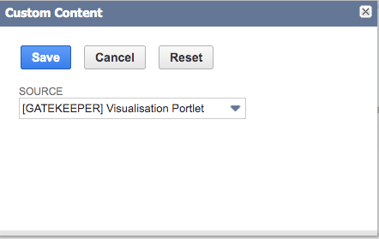
- You should now see your Gatekeeper Tenant within NetSuite.
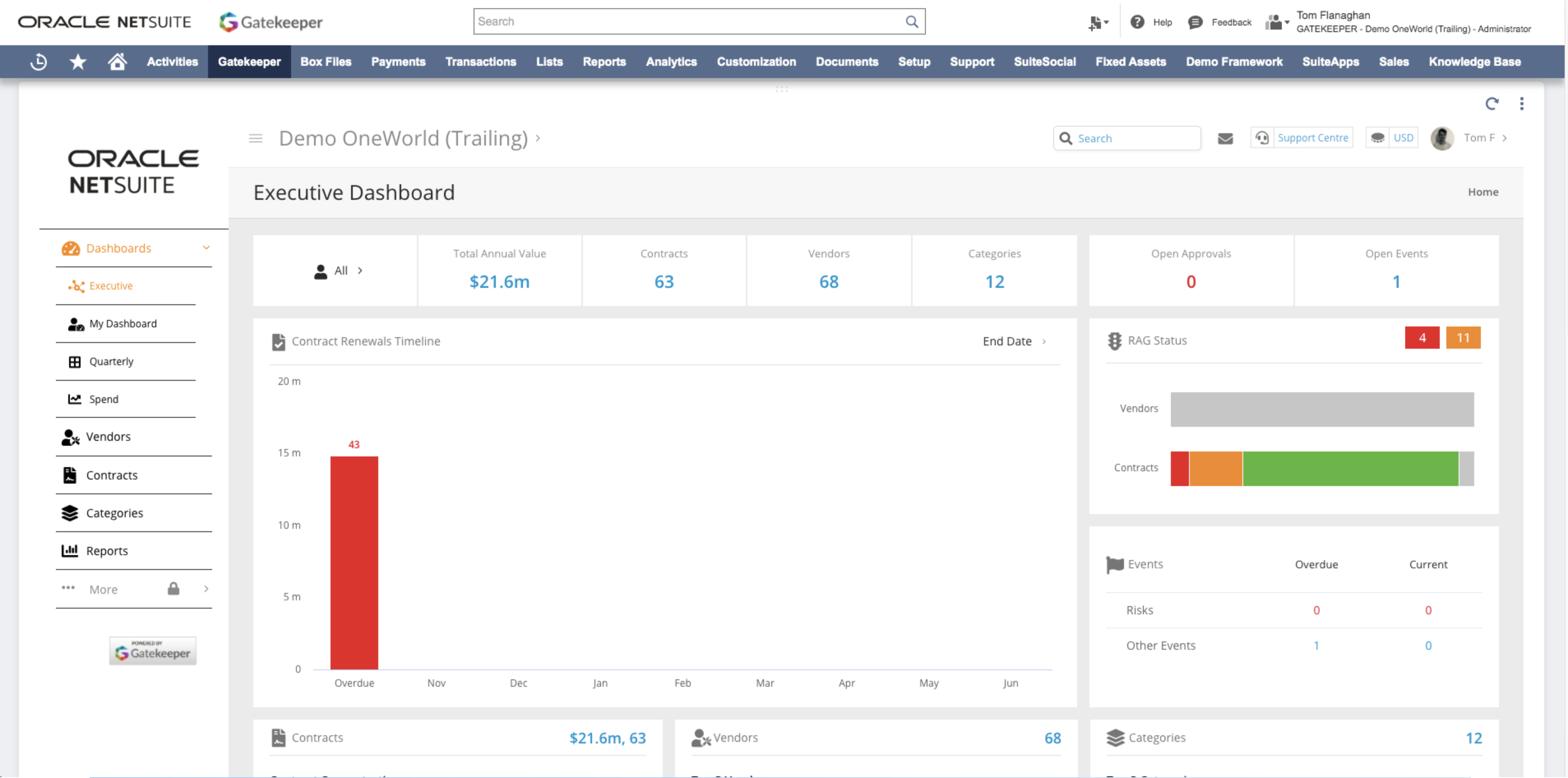
Enable the Spend Integration for your Sandbox
Note: The Spend Integration is disabled by default for Sandbox accounts. This is to prevent both your Production and Sandbox accounts sending spend data to Gatekeeper at the same time.
- In NetSuite, navigate to Setup > Custom > Gatekeeper Setup

- If the advanced settings do not display for your sandbox, add "&advanced=true" to the URL of the page. This will display the Advanced features.

- Select the Run Spend Integration in Sandbox checkbox.

Gatekeeper Setup Steps
The following sections of this guide will cover the setup steps required in Gatekeeper.
Configure Gatekeeper
Note: Users require the Administrator role and Configuration additional permission to complete these steps.
- From the navigation menu, expand Settings then click Configuration.
- Click NetSuite.
- Switch on the Enabled toggle.

- Input the details you noted down whilst configuring NetSuite.

- Click Save.
- If you have a NetSuite OneWorld account, select the OneWorld checkbox and select a default subsidiary from the dropdown to assign created vendors.
- Click Save.

Configure Field Mapping
Note:
- Gatekeeper does not have visibility into any fields you've flagged as mandatory in your NetSuite instance, including custom fields. To avoid errors, ensure all mandatory NetSuite fields are mapped appropriately in Gatekeeper.
- Users require the Administrator role and Configuration additional permission to complete these steps.
Field mapping allows you to align data between Gatekeeper and NetSuite, ensuring that key information (like vendor names or categories) is transferred correctly.
To do this:
- From the navigation menu, expand Settings then click Configuration.
- Click NetSuite.
- Click the Field Mapping tab.
- To create a new mapping, click Add Field.

- Select the required Gatekeeper field to map to the required NetSuite field, then click Save.

Continue mapping fields until all required NetSuite fields, especially those marked as mandatory, have been mapped in Gatekeeper.
Note: If you require additional custom data fields within Gatekeeper as part of this process, please see Configure Custom Data.
Map Currencies
To map currencies from Gatekeeper to NetSuite:
- Create a custom data field with the type of dropdown list. See Configure Custom Data for step-by-step instructions.
- Add the required currencies as an option using the relevant ISO 4217 code only, e.g. USD for USD Dollar. Do not include extra text such as USD: US Dollar as this can cause sync errors.

- Map the Gatekeeper field to the Currency NetSuite field.

Note: The ISO codes added to the Gatekeeper dropdown custom field must exist in NetSuite, otherwise the field will not sync. To view the currencies set up in NetSuite, go to Lists > Accounting > Currencies. The list displays all currencies and their corresponding ISO codes.

Supported Field Mapping Table
Both Vendor Core Data and Vendor Custom Data can be used for Gatekeeper Field Mapping. See the below table for further details on how Gatekeeper field types can be mapped to NetSuite Custom Entity Types.
Note: In the instance of a NetSuite Custom Entity Type that can be associated with dropdown values, the values for NetSuite must be entered manually. Each entry must exactly match the values in your NetSuite instance.
| Gatekeeper Field Type | Corresponding NetSuite Custom Entity Type(s) |
| Single/Multi-Line Text |
|
|
Multi-Line Text |
|
|
Single-Line Text |
|
| Address |
|
| Yes/No |
|
| Integer |
|
| Float |
|
| **Single Dropdown List |
|
| Multi-pick Dropdown List |
|
| Attachment |
|
| **Custom Entity |
|
**Default Subsidiary
The default Subsidiary field will only map to one singular Entity, and is a mandatory field.
If you would like to map more than one Subsidiary, you can create a custom data field against the vendor record of the type Entity, or map a Multi-select dropdown which can then be used to override the default Subsidiary field.
Sync Vendor Data
You can manually sync vendors to NetSuite from the repository, or do this via workflows.
Sync Vendors to NetSuite from the Repository
If you have vendors in Gatekeeper to sync with NetSuite, but do not have a workflow in place for this, certain admin users can manually push metadata records directly from the Gatekeeper repository to NetSuite.
Note: To facilitate a structured synchronisation with NetSuite, consider implementing one of the following workflows:
- Vendor Onboarding - to sync newly added vendors after they complete onboarding.
- Simple NetSuite Update Request - to allow internal users to request updates to vendor data in Gatekeeper and NetSuite.
- Vendor Portal Update Request Form - to allow the vendor themselves to request updates to vendor data in Gatekeeper and NetSuite.
Part 1 - Grant the NetSuite Sync Permission
- From the navigation menu, expand Settings then click Users.
- Expand the three dots on the relevant user, then select Edit.
- Select the NetSuite Administrator checkbox in the Additional Permissions section.
- Click Save.

Note: This permission can be enabled en-masse via a bulk user update.
Part 2 - Perform the Sync
Once you have the required permission, you can sync a vendor to NetSuite by following the below steps:
- From the navigation menu, expand the Vault and click Vendors.
- Click a vendor to open their record.
- Click Sync to NetSuite.
Note: Once a vendor has been synced to NetSuite, you can push a manual re-sync of data by clicking NetSuite then selecting Sync to NetSuite.
Enable the Sync to NetSuite actions in Workflows
Note: Ensure that all configuration steps have been completed successfully before attempting to enable the actions within workflows.
- Navigate to the workflow and click on the relevant phase to edit it.
- Click Actions, then select the Sync to NetSuite on Action checkbox.

All vendors that have this action executed will now be synced to NetSuite.
View NetSuite synced Vendors in Gatekeeper
Once you have synced a vendor to NetSuite, the vendor record in Gatekeeper will display a link to the associated record in NetSuite.

You can also enable a new column in the vendor repository view to see which vendors have been synced to NetSuite.

Unlink Vendors from NetSuite
Administrators can unlink a vendor from NetSuite directly from Gatekeeper. This allows you to halt data synchronisation for a specific vendor, while retaining historic data in Gatekeeper.
To do this:
- From the navigation menu, expand the Vault and click Vendors.
- Click a vendor to open their record.
- Click NetSuite then select Unlink Vendor.
-
To proceed, you must type Unlink in the confirmation field.
-
Click Unlink.
Note: If you later choose to re-sync the vendor, click Sync to NetSuite to do this. The system will automatically re-link the vendor to the original NetSuite record using the same ID. Data will resume syncing from that point onward.
Link Vendors Manually to NetSuite
You can manually link a vendor record in Gatekeeper to a vendor in NetSuite. To do this:
- From the navigation menu, expand the Vault and click Vendors.
- Click a vendor to open their record.
- Click NetSuite then select Set NetSuite ID.

- Enter the NetSuite Vendor ID.
- To proceed, you must type Link in the confirmation field, then click Link Vendor.
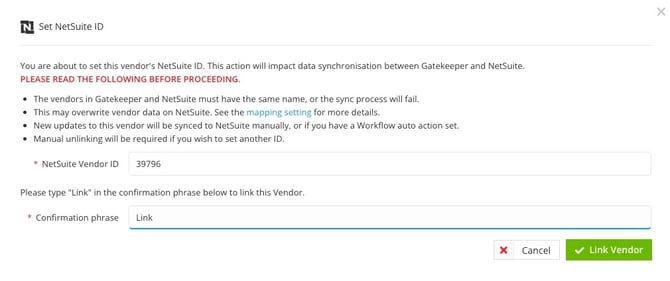
-
Once linked, click Sync to NetSuite to initiate data syncing.
Note: The vendor name in Gatekeeper must match the vendor name in NetSuite for the records to link correctly.
Troubleshooting
Use the following sections to help resolve issues with the NetSuite integration.
Upgrade the SuiteApp
It's recommended to regularly update the SuiteApp in order to access new features, enhancements, and issue fixes. To do this:
- Follow steps 1-2 from Installation
- Click Upgrade.
This page will display the progress and, once complete, will return the status to Installed.
Access Request Logs
If you experience issues syncing data from Gatekeeper to NetSuite, you can access the integration logs directly from your Gatekeeper tenant:
Note:
- Logs are retained for seven days before.
- Users require the Configuration additional permission to access the logs.
- From the navigation menu, expand Settings then click Configuration.
- Click NetSuite.
- Click the Request Log tab.
This displays each request Gatekeeper sends to NetSuite. Click the links in the Details column for further information.
If you require help interpreting the logs, please raise a support ticket.
Frequently Asked Questions
Q: Our NetSuite instance does not have the Tax ID field. How can we map to this field?
A: In some instances, NetSuite does not include the Tax ID field. Instead, you can map your data to the VAT Registration Number Field.
Q: A vendor has been unlinked from NetSuite and re-synced, but the expected data is not appearing. What is the cause of this?
A: Spend created while the vendor was unlinked does not sync back into Gatekeeper, even if the vendor is relinked. This is by design to ensure the integrity of linked data.